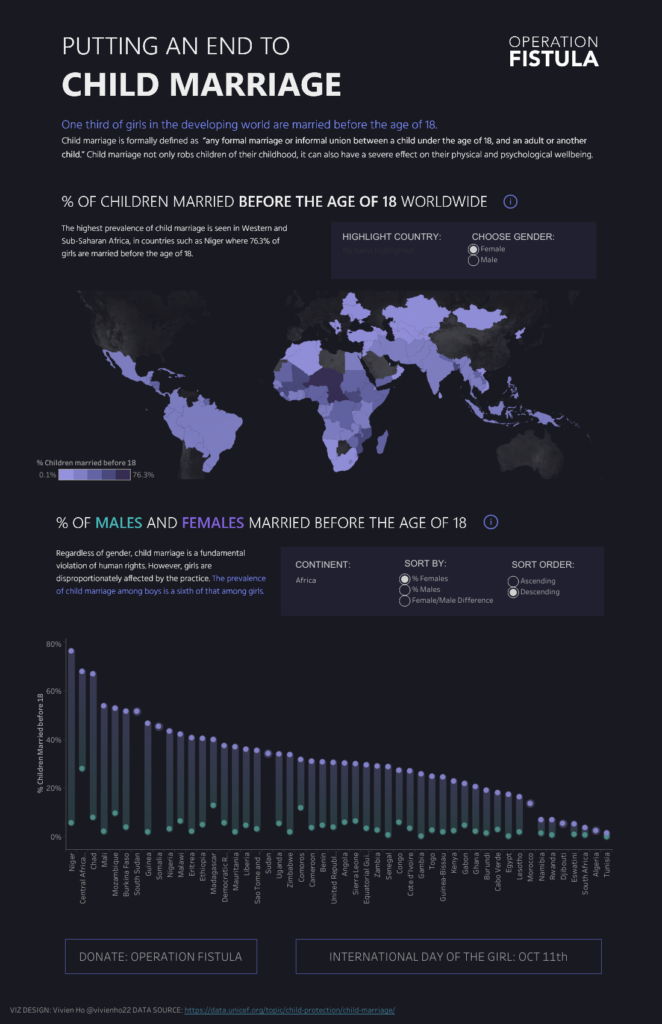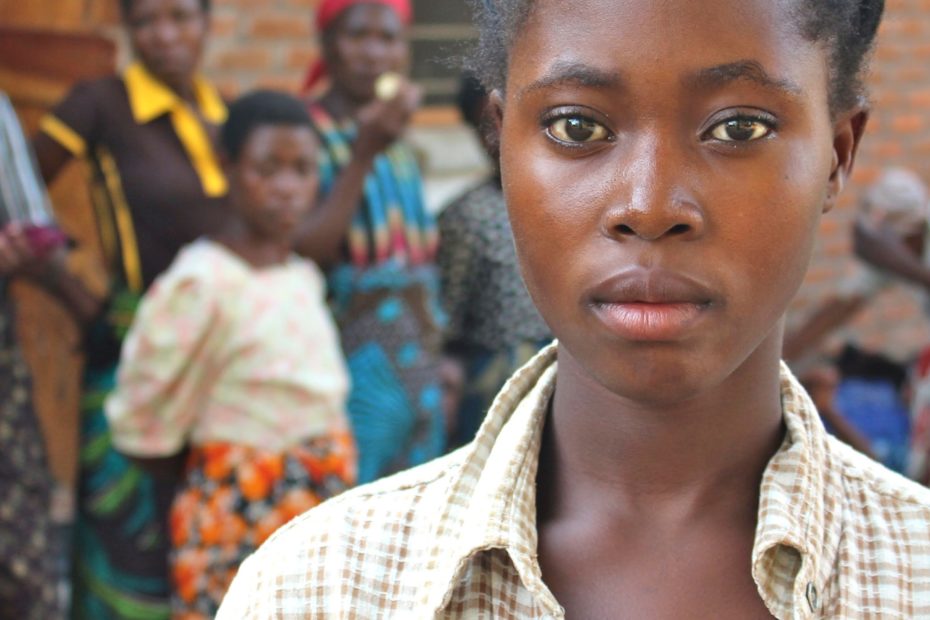The month of October sees the annual celebration of International Day of the Girl. This day aims to raise awareness and bring global attention to the needs and challenges faced by girls. It also seeks to magnify, propel, and amplify the empowerment of girls, and the fulfillment of their human rights.
“Girls face multiple challenges purely because of their age and gender. In many of the world’s poorest places, the odds are stacked against them when factors like ethnicity and disability heighten the existing disadvantages that they face. From being denied an education to being forced into child marriage, girls face a myriad of obstacles that prevent them from realizing their full potential.” – ActionAid UK
This year Operation Fistula invited the Viz5 community into our preparations for International Day of the Girl, to raise awareness of child marriage through data visualization.
Child Marriage
Child marriage is formally defined as: “any formal marriage or informal union between a child under the age of 18 and an adult or another child.” [1] It is a symptom of extreme and entrenched gender inequality, and girls are disproportionately affected by the practice. While it affects children of both sexes, globally, the prevalence among boys is just one sixth of that among girls. Regardless of gender, child marriage is a fundamental violation of human rights.
Child marriage is rooted in inequality between men and women and discriminatory views towards a girl’s value, sexuality, and role in society. Ending child marriage is a strategic way of tackling gender inequality and shifting the discriminatory norms that perpetuate child marriage. – Girls Not Brides
The impact of child marriage on a girl’s life is truly devastating. Not only does child marriage rob girls of their childhood, but it also has extremely negative consequences for their lives, health, and wellbeing. Girls who are married as children are exponentially more likely to experience domestic and sexual violence, and their educational journeys nearly always come to an end, severely limiting their career opportunities, and their chances of economic and vocational development.
Child marriage also has a severe and significant impact on girls’ physical health and psychosocial wellbeing. Child brides are frequently subjected to profound pressure to bear children, but their bodies – not yet fully grown – are not physically ready for pregnancy and childbirth. This has deeply negative consequences. Every year, approximately 70,000 adolescent girls in Low – and Middle-Income Countries (LMICs) die during childbirth, or as a result of pregnancy and childbirth related complications. 70,000 girls. It’s an unfathomable number, and we must collectively act to end child marriage and child pregnancy.
How We’re Telling the Story Through Data
At Operation Fistula we know that child mothers have an exponentially increased risk of suffering devastating injuries like obstetric fistula during childbirth. It is an injury that in 90% of cases leads to their baby being stillborn, and leaves the mothers uncontrollably leaking urine and/or feces, resulting in extreme social ostracism and physical suffering. Ending child marriage and child pregnancy is, therefore, a critical and clear priority for our mission to end fistula, and our commitment to ending the gender inequality that causes it.
The data on child marriage that Viz5 shared for International Day of the Girl, came from Unicef and was compiled from Demographic Health Surveys (DHS) and Multiple Indicator Cluster Surveys (MICS). These surveys reach vast swathes of each country’s national populace, and in this case, the data was compiled from estimates produced from survey responses in a subset of 128 countries, where approximately 70% of the population was surveyed.
The dataset presented the percentage of women aged 20 to 24 years who were first married, or in union, before age 15. It also covered the percentage of women, and the percentage of men, aged 20 to 24 years who were first married or in union before age 18.
The Impact of Data Visualization
The Viz5 community’s response to this data challenge was incredible! We saw a vast number of data visualization submissions. It’s been inspiring and moving to see the community engage such a difficult topic with such deep sensitivity. Everyone worked hard to capture the stories in the data, and share visualizations that not only capture the devastating impact of child marriage, but also connect their audience to further information and resources for International Day of the Girl.
Our SuperViz for October, came from Vivien Ho – @vivienho22. Their visualization, entitled “Putting an End to Child Marriage,” gave a comprehensive overview of the data, told a really compelling story, and linked the data to the work of Operation Fistula and the global community of advocates preparing for International Day of the Girl. Check it out:

We had so many incredible submissions for October that we also wanted to highlight and recognize one of our previous SuperViz winners – Agata Ketterick – @agatavizz. Agata submitted a stunning data visualization, with great detail on the theme, and a stark presentation of the proportion of girls in each country that were married as children. She also did a great job of spotlighting the Viz5 movement and encouraging her viewers to donate to Girls Not Brides, an NGO doing critically important work to advocate for girls and end child marriage. Great work, Agata! Take a look, here:

How You Can Get Involved:
The goal of ending child marriage is connected to many of the other SDG targets, and should not be viewed in isolation. To learn more about the interconnections between child marriage and the other SDG targets, watch this video from Girls Not Brides, or read their insightful Fact Sheet.
Today, the total number of girls who are married as children is approximately 12 million per year. If we do not accelerate the work to end child marriage, we will not reach the SDG target by 2030, and in excess of 120 million additional girls will be married by their 18th birthday. This is totally unacceptable.
Make your voice heard by calling for an end to child marriage this International Day of the Girl. Use #EndChildMarriage and #DayoftheGirl to connect with the global conversation. We also encourage you to share stories and information to amplify the voices of girls everywhere, and celebrate their leadership, bravery, action, and impact!
—
Keep a look out for more updates from #Viz5 and the visualize gender equality movement.
Want to join our community? Sign up at www.viz5.org!
About Viz5
The ultimate goal of Viz5 is to create a space where data advocacy and insights meet impact. This work seeks to ignite a data advocacy effort with the power to not only raise awareness of extreme gender inequality, but also catalyze global action to end it.
Viz5 is led by Operation Fistula, with #MakeoverMonday and Tableau Foundation operating as critical partners.
The visualizations that are produced during Viz5 will serve as advocacy tools, awareness-raising artifacts, and data-driven insight drivers for anyone working to end gender inequality.
